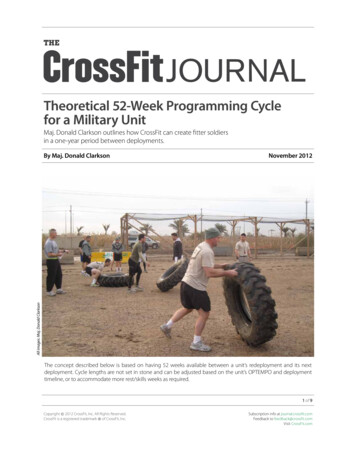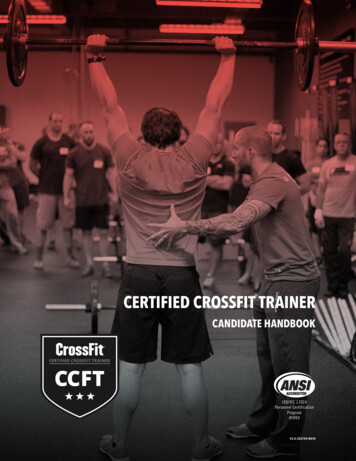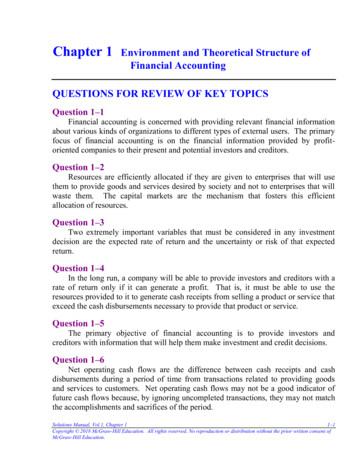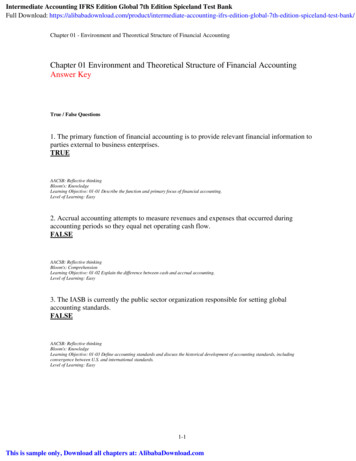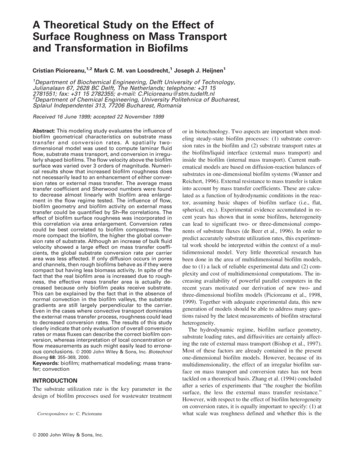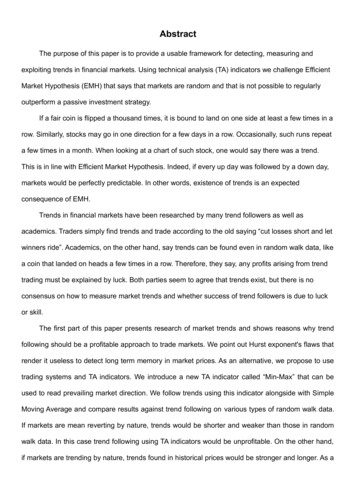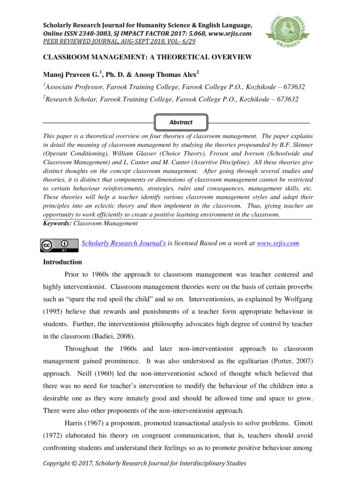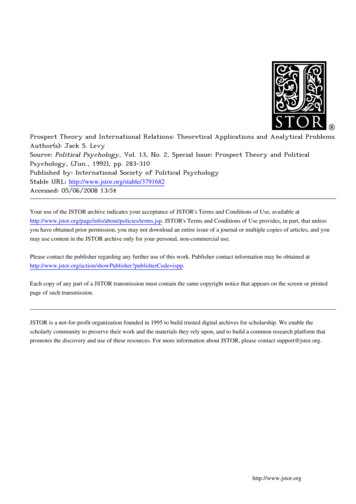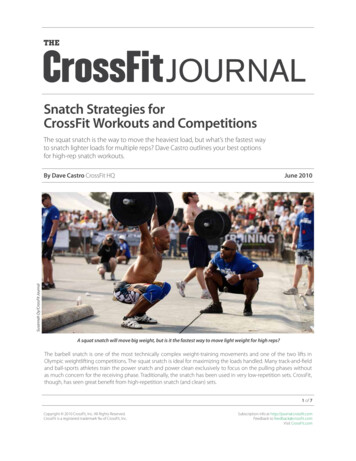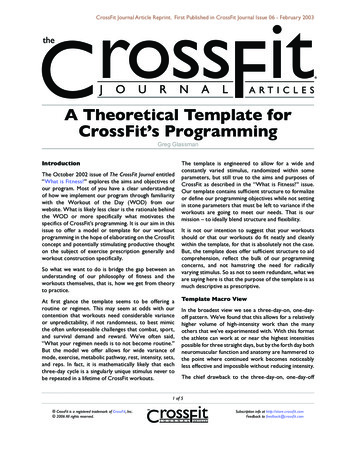
Transcription
CrossFit Journal Article Reprint. First Published in CrossFit Journal Issue 06 - February 2003A Theoretical Template forCrossFit’s ProgrammingGreg GlassmanIntroductionThe October 2002 issue of The CrossFit Journal entitled“What is Fitness?” explores the aims and objectives ofour program. Most of you have a clear understandingof how we implement our program through familiaritywith the Workout of the Day (WOD) from ourwebsite. What is likely less clear is the rationale behindthe WOD or more specifically what motivates thespecifics of CrossFit’s programming. It is our aim in thisissue to offer a model or template for our workoutprogramming in the hope of elaborating on the CrossFitconcept and potentially stimulating productive thoughton the subject of exercise prescription generally andworkout construction specifically.So what we want to do is bridge the gap between anunderstanding of our philosophy of fitness and theworkouts themselves, that is, how we get from theoryto practice.At first glance the template seems to be offering aroutine or regimen. This may seem at odds with ourcontention that workouts need considerable varianceor unpredictability, if not randomness, to best mimicthe often unforeseeable challenges that combat, sport,and survival demand and reward. We’ve often said,“What your regimen needs is to not become routine.”But the model we offer allows for wide variance ofmode, exercise, metabolic pathway, rest, intensity, sets,and reps. In fact, it is mathematically likely that eachthree-day cycle is a singularly unique stimulus never tobe repeated in a lifetime of CrossFit workouts.The template is engineered to allow for a wide andconstantly varied stimulus, randomized within someparameters, but still true to the aims and purposes ofCrossFit as described in the “What is Fitness?” issue.Our template contains sufficient structure to formalizeor define our programming objectives while not settingin stone parameters that must be left to variance if theworkouts are going to meet our needs. That is ourmission – to ideally blend structure and flexibility.It is not our intention to suggest that your workoutsshould or that our workouts do fit neatly and cleanlywithin the template, for that is absolutely not the case.But, the template does offer sufficient structure to aidcomprehension, reflect the bulk of our programmingconcerns, and not hamstring the need for radicallyvarying stimulus. So as not to seem redundant, what weare saying here is that the purpose of the template is asmuch descriptive as prescriptive.Template Macro ViewIn the broadest view we see a three-day-on, one-dayoff pattern. We’ve found that this allows for a relativelyhigher volume of high-intensity work than the manyothers that we’ve experimented with. With this formatthe athlete can work at or near the highest intensitiespossible for three straight days, but by the forth day bothneuromuscular function and anatomy are hammered tothe point where continued work becomes noticeablyless effective and impossible without reducing intensity.The chief drawback to the three-day-on, one-day-off1 of 5 CrossFit is a registered trademark of CrossFit, Inc. 2006 All rights reserved.Subscription info at http://store.crossfit.comFeedback to feedback@crossfit.com
Theoretical Template for CF Programming (continued.)Table 1 - Template Macro ViewDay1M2GWDaywk 11M2GWwk 2Gwk 3W3MGW4OFF3 days on, 1 day off567GWGMWM5 days on, 2 days gimen is that it does not sync with the five-day-on,two-day-off pattern that seems to govern most ofthe world’s work habits. The regimen is at odds withthe seven-day week. Many of our clients are runningprograms within professional settings, often academic,where the five-day workweek with weekends off is derigueur. Others have found that the scheduling needs offamily, work, and school require scheduling workouts onspecific days of the week every week. For these peoplewe have devised a five-days-on, two-days-off regimenthat has worked very well.8OFF9W10MG11WMG12OFFModalitiesM monostructural metabolicconditioning or “cardio”G gymnastics, bodyweightexercisesW weightlifting, powerlifting andolympic liftseffective pattern. There are other factors that willultimately overshadow any disadvantages inherent in thepotentially less effective regimen, such as convenience,attitude, exercise selection, and pacing.For the remainder of this article the three-day cycleis the one in discussion, but most of the analysis anddiscussion applies perfectly to the five-day cycle.Elements by ModalityLooking at the Template Macro View (Table 1) it canreadily be seen that the workouts are composedThe workout of the day was originally a five-on, two- of three distinct modalities: metabolic conditioningoff pattern and it worked perfectly. But the three(“M”), gymnastics (“G”),on, one-off pattern wasand weightlifting (“W”).devised to increase both theThe metabolic conditioningintensity and recovery of theis monostructural activities.the model we offer allows forworkouts and the feedbackcommonly referred to aswe’ve received and ourwide variance of mode, exercise,“cardio,” the purpose ofobservations suggest that itwhich is primarily to improvemetabolicpathway,rest,intensity,was successful in this regard.cardiorespiratory capacitysets, and reps.and stamina. The gymnasticsIf life is easier with the fivemodality comprises bodyon, two-off pattern, don’tweight exercises/elementshesitate to employ it. Thedifference in potential between the two may not warrant or calisthenics and its primary purpose is to improverestructuring your entire life to accommodate the more body control by improving neurological components2 of 5 CrossFit is a registered trademark of CrossFit, Inc. 2006 All rights reserved.Subscription info at http://store.crossfit.comFeedback to feedback@crossfit.com
Theoretical Template for CF Programming (continued.)Table 2 - Exercises by ModalityGymnasticsMetabolic ConditioningWeightliftingAir SquatPull-upPush-upDipHandstand Push-upRope ClimbMuscle-UpPress to HandstandBack ExtensionSit-upJumpsLungesRunBikeRowJump RopeDeadliftsCleansPressesSnatchClean and JerkMedicine Ball DrillsKettlebell Swinglike coordination, balance, agility, and accuracy, andto improve functional upper body capacity and trunkstrength. The weightlifting modality comprises themost important weight training basics, Olympic liftsand powerlifting, where the aim is primarily to increasestrength, power, and hip/leg capacity.Table 2 gives the common exercises used by ourprogram, separated by modality, in fleshing out theroutines.For metabolic conditioning the exercises are run, bike,row, and jump rope. The gymnastics modality includesair squats, pull-ups, push-ups, dips, handstand push-ups,rope climb, muscle-ups, presses to handstand, back/hipextensions, sit-ups, and jumps (vertical, box, broad,etc.). The weightlifting modality includes deadlifts,cleans, presses, the snatch, the clean and jerk, medicineball drills and throws, and kettlebell swings.The elements, or exercises, chosen for each modalitywere selected for their functionality, neuroendocrineresponse, and overall capacity to dramatically andbroadly impact the human body.Workout StructureThe workouts themselves are each represented bythe inclusion of one, two, or three modalities for eachday. Days 1, 5, and 9 are each single modality workoutswhereas days 2, 6, and 10 include two modalities each,and finally, days 3, 7, and 11 use three modalities each.In every case each modality is represented by a singleexercise or element, i.e., each M, W, and G represents asingle exercise from metabolic conditioning, weightlifting,and gymnastics modalities respectively.When the workout includes a single exercise (days 1, 5,and 9) the focus is on a single exercise or effort. Whenthe element is the single “M” (day 1) the workout isa single effort and is typically a long, slow, distanceeffort. When the modality is a single “G” (day 5) theworkout is practice of a single skill and typically thisskill is sufficiently complex to require great practice andmay not be yet suitable for inclusion in a timed workoutbecause performance is not yet adequate for efficientinclusion. When the modality is the single “W” (day 9)the workout is a single lift and typically performed athigh weight and low rep. It is worth repeating that thefocus on days 1, 5, and 9 is single efforts of “cardio”at long distance, improving high-skill more complexgymnastics movements, and single/low rep heavyweightlifting basics, respectively. This is not the day towork sprints, pull-ups, or high rep clean and jerk - theother days would be more appropriate.On the single-element days (1, 5, and 9), recovery isnot a limiting factor. For the “G” and “W” days restis long and deliberate and the focus is kept clearly onimprovement of the element and not on total metaboliceffect.For the two-element days (2, 6, and 10), the structureis typically a couplet of exercises performed alternately3 of 5 CrossFit is a registered trademark of CrossFit, Inc. 2006 All rights reserved.Subscription info at http://store.crossfit.comFeedback to feedback@crossfit.com
Theoretical Template for CF Programming (continued.)Table 3 - Workout StructureDaysSingle-Element Days(1, 5, 9)Two-Element Days(2, 6, 10)Three-Element Days(3, 7, 11)PriorityElement PriorityTask PriorityTime PriorityStructure(set structure)M: Single EffortG: Single SkillW: Single LiftCouplet repeated 3-5times for timeTriplet repeated for 20minutes for rotations(intensity)M: Long, Slow DistanceG: High SkillW: HeavyTwo moderately tointensely challengingelementsThree lightly tomoderately challengingelementsWork RecoveryCharacterRecovery not a limitingfactorWork/rest intervalmanagement criticalWork/rest intervalmarginal factoruntil repeated for a total of 3, 4, or most commonly 5rounds and performed for time. We say these days are“task priority” because the task is set and the time varies.The workout is very often scored by the time requiredto complete five rounds. The two elements themselvesare designed to be moderate to high intensity and workrest interval management is critical. These elements aremade intense by pace, load, reps or some combination.Ideally the first round is hard but possible, whereas thesecond and subsequent rounds will require pacing, rest,and breaking the task up into manageable efforts. If thesecond round can be completed without trouble, theelements are too easy.For the three-element days (3, 7, and 11), the structureis typically a triplet of exercises, this time repeated for20 minutes and performed and scored by number ofrotations completed in twenty minutes. We say theseTable 4 - Workout ExamplesDays123456789101112MGWMGWGWMGWMWMGWMGRun 10K(5 handstand push-ups/225 x 5 deadlifts 20 lbs/round) x 5 for timeRun 400m/10 pull-ups/”Thruster” 50% BW x 15 for 20 min for rotationsOFFPractice handstands for 45 minutes(Bench press 75% BW x 10/Row 500m) x 5 for timeLunges 100ft./push-press 50% BW x 15/row 500 m for 20 min for rotationsOFFDeadlift 5-3-3-2-2-2-1-1-1 reps(Run 200m/box jump 30 in x 10) x 5 for timeClean 50% BW x 20/bike 1 mile/15 push-ups for 20 min for rotationsOFF4 of 5 CrossFit is a registered trademark of CrossFit, Inc. 2006 All rights reserved.Subscription info at http://store.crossfit.comFeedback to feedback@crossfit.com
Theoretical Template for CF Programming (continued.)workouts are “time priority” because the athlete is keptmoving for a specified time and the goal is to completeas many cycles as possible. The elements are chosen inorder to provide a challenge that manifests only throughrepeated cycles. Ideally the elements chosen are notsignificant outside of the blistering pace required tomaximize rotations completed within the time (typically20 minutes) allotted. This is in stark contrast to the twoelement days, where the elements are of a much higherintensity. This workout is tough, extremely tough, butmanaging work-rest intervals is a marginal factor.Each of the three distinct days has a distinct character.Generally speaking, as the number of elements increasesfrom one to two to three, the workout’s effect is dueless to the individual element selected and more to theeffect of repeated efforts.ApplicationThe template in discussion did not generate our Workoutof the Day, but the qualities of one, two, and threeelement workouts motivated the template’s design.Our experience in the gym and the feedback from ourathletes following the WOD have demonstrated thatthe mix of one, two, and three element workouts arecrushing in their impact and unrivaled in bodily response.The information garnered through your feedback on theWOD has given CrossFit an advantage in estimating andevaluating the effect of workouts that may have takendecades or been impossible without the Internet.Typically our most effective workouts, like art, areremarkable in composition, symmetry, balance, theme,and character. There is a “choreography” of exertionthat draws from a working knowledge of physiologicalresponse, a well-developed sense of the limits ofhuman performance, the use of effective elements,experimentation, and even luck. Our hope is that thismodel will aid in learning this art.The template encourages new skill development,generates unique stressors, crosses modes, incorporatesquality movements, and hits all three metabolic pathways.It does this within a framework of sets and reps and acast of exercises that CrossFit has repeatedly tested andproven effective. We contend that this template doesa reasonable job of formally expressing many CrossFitobjectives and values.Greg Glassman is the founder (with LaurenGlassman) of CrossFit, Inc. and CrossFit SantaCruz and is the publisher of the CrossFit Journal.5 of 5 CrossFit is a registered trademark of CrossFit, Inc. 2006 All rights reserved.Subscription info at http://store.crossfit.comFeedback to feedback@crossfit.com
CrossFit’s Programming Greg Glassman 1 of 5 Introduction The October 2002 issue of The CrossFit Journal entitled “What is Fitness?” explores the aims and objectives of our program. Most of you have a clear understanding of how we implement our program through familiarity with the Workout of the Day (WOD) from our website. What is likely less clear is the rationale behindFile Size: 335KBPage Count: 5
